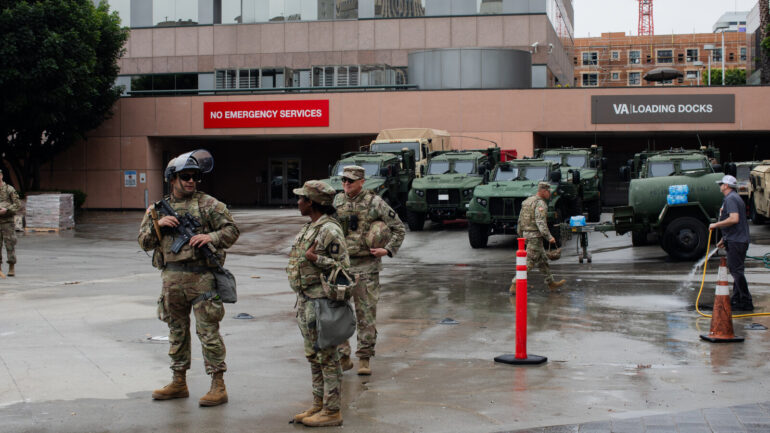Los Angeles has become a flashpoint of unrest following immigration raids that sparked days of protests, a citywide curfew, and the controversial deployment of thousands of National Guard troops and U.S. Marines. The situation, which began with federal immigration operations on June 6, 2025, has escalated into a heated clash between state and federal authorities, with California leaders accusing President Donald Trump of inflaming tensions for political gain.
A City Under Curfew
On Tuesday, June 10, 2025, Los Angeles Mayor Karen Bass imposed an 8 p.m. to 6 a.m. curfew in a one-square-mile area of downtown Los Angeles, stretching from the 5 Freeway to the 110 Freeway and from the 10 Freeway to where the 110 and 5 Freeways merge. The curfew, expected to last several days, was a response to five nights of protests that turned violent, resulting in over 20 businesses looted, widespread vandalism, and nearly 400 arrests across the city.
“The imagery of the protests and violence might make it seem like this is a citywide crisis, but it’s not,” Bass said during a press conference. She emphasized that the unrest was confined to a small area of the city’s 502 square miles, but the deployment of federal troops has complicated efforts to restore calm.
Protests Erupt After Immigration Raids
The unrest began last Friday when Immigration and Customs Enforcement (ICE) conducted raids in the Westlake District, downtown, and South Los Angeles, arresting 45 people, including local union leader David Huerta. Protesters quickly gathered, attempting to block federal agents from detaining individuals. Over the weekend, demonstrations grew chaotic, with hundreds flooding the 101 Freeway, clashing with California Highway Patrol officers, and, in one instance, setting fire to Waymo vehicles.
By Tuesday, tensions escalated further outside the Edward R. Roybal Federal Building, where protesters threw projectiles at National Guard troops. When the curfew took effect at 8 p.m., Los Angeles Police Department (LAPD) officers moved in, detaining dozens of people who lingered in the area. Aerial footage captured by CBS News Los Angeles showed groups of protesters tagging buildings and Metro buses before dispersing.
California vs. the Federal Government
The deployment of 2,000 National Guard troops and 700 U.S. Marines to Los Angeles, ordered by President Trump, has drawn sharp criticism from California leaders. Governor Gavin Newsom, in a statewide address on Tuesday, called the move an “abuse of power” that “fanned the flames” of an already tense situation. He accused Trump of deploying troops without consulting state officials, putting residents, officers, and even National Guard members at risk.
“This is not law enforcement—it’s authoritarianism,” Newsom said. “What Donald Trump wants most is your silence, your fealty, to be complicit in this moment. Do not give in to him.”
California Attorney General Rob Bonta has taken legal action, filing for a temporary restraining order to halt further troop deployments and arguing that the federal government’s actions violate the Tenth Amendment. Mayor Bass echoed these sentiments, stating that Los Angeles was “peaceful” before the immigration raids began.
In response, Trump posted on Truth Social, calling Newsom “incompetent” and claiming the National Guard was necessary to protect ICE officers from “an out-of-control mob of agitators, troublemakers, and/or insurrectionists.” During a speech at Fort Bragg, he described the protests as “a full-blown assault on peace, public order, and national sovereignty,” alleging that many demonstrators were “rioters bearing foreign flags.”
Voices of Protest and Concern
California Senator Alex Padilla, a Los Angeles native and son of Mexican immigrants, called the situation a “crisis of Donald Trump’s making.” Speaking with CBS News, he denounced the “aggressive and cruel tactics” of ICE, which he said targeted not only violent criminals but also “hardworking women and men, children.” Padilla argued that the presence of federal troops was “counterproductive,” heightening tensions rather than resolving them.
A Charged Incident
On Wednesday, the Department of Homeland Security announced the arrest of Emiliano Garduno-Galvez, a previously deported Mexican citizen with a criminal record, charged with attempted murder for allegedly throwing a Molotov cocktail at law enforcement during the protests. Assistant Secretary Tricia McLaughlin stated, “These are the types of criminal illegal aliens that rioters are fighting to protect,” underscoring the Trump administration’s stance on immigration enforcement.
A Nation Watches as Marines Prepare
The 700 Marines, still undergoing training outside Los Angeles as of Wednesday morning, are part of a federal effort to protect personnel and property amid the protests. According to a U.S. Northern Command spokesperson, the Marines have not yet completed their non-lethal crowd-control training, leaving their deployment timeline unclear. Footage from CNN affiliates showed Marines practicing detainment techniques, highlighting their role in potential escalations.
Nationwide, the unrest has inspired protests in cities like New York, Chicago, Austin, and Washington, D.C. In Santa Ana, California, a demonstration on Monday saw protesters throwing fireworks at law enforcement, who responded with smoke canisters and pepper balls. By Tuesday, protests there were more peaceful.
A City on Edge
As Los Angeles navigates this turbulent moment, the deployment of Marines underscores a growing divide between state and federal powers. With California leaders calling for de-escalation and the Trump administration intensifying its response, the protests raise critical questions about authority, public safety, and the rights of residents. With more demonstrations planned across the country, Los Angeles remains a city on edge, caught between the demands of its people and the actions of its leaders.
